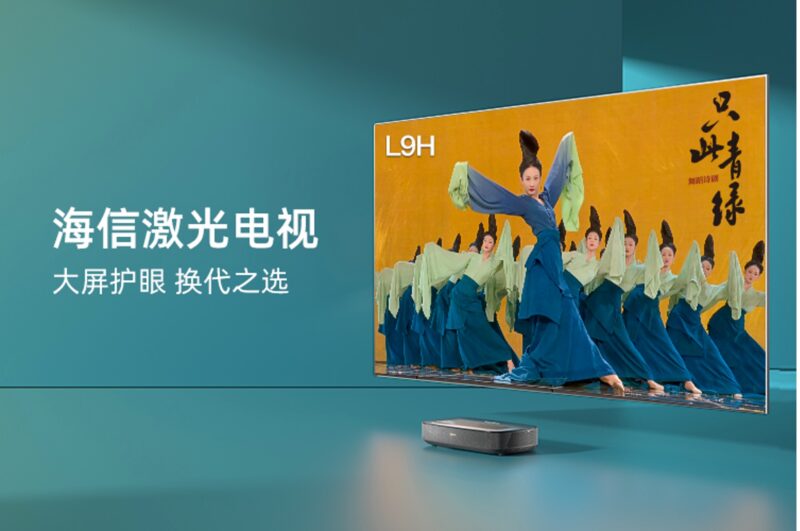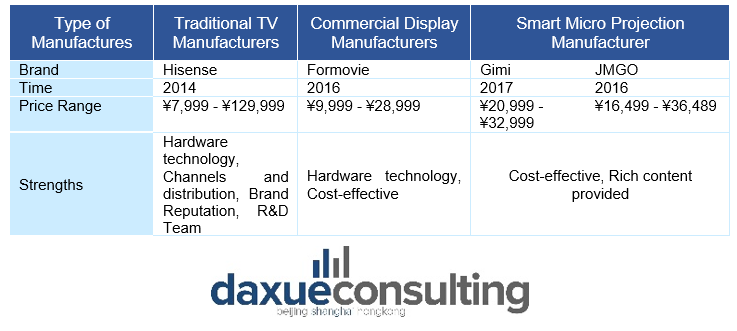Laser display technology is a new generation of display technology following black and white TV, standard color TV and digital TV represented by LCD TV, PDP, OLED, etc. Laser TVs utilize optical rays of different colors project the image onto a screen.
In 2020, the penetration rate of laser TVs was still less than 1%, but it is expected to exceed 3% in 2025 with a sales volume of 1.5 million units. In recent years, laser TV technology has gradually matured especially in the field of large-screen TVs. The penetration rate of laser TVs among larger than 75-inch screen TVs has already reached 9.4% in 2020 and it is expected to hit at 26% in 2025.
The unique selling points of laser TVs
Compared to other TV display, laser TVs do have differentiated themselves in the market with several unique selling points.
Impressive immersion
The most popular TV screen sizes have steadily grown over the last decade or so. In 2020, the average size of domestic TV products was 51.2 inches, an increase of 1.0 inches from the previous year. The retail sales of products above 65 inches accounted for 24.8% of the overall B2C sales, an increase of 6.5 percentage points over the same period last year.
Among the current display technologies, only LCD TVs and laser TVs have a mass production capacity of TVs that are larger than 80 inches. Laser TVs have brought many positive changes to TV viewing. Whether you are projecting onto a wall or a screen, laser TVs easily deliver a much larger picture than most flat-panel TVs. By placing the device on the TV stand, you can project up to 120’’. At the same time, it supports 1080P or 4K display resolution. At this resolution, you can see every detail and close-up in the picture. Coupled with a built-in sound system, laser TVs allow audience to have an immersive experience at home.
Perfect color reproduction
Laser display technology boasts high brightness, strong color concentration, and extremely small divergence that natural light cannot match. It is especially suitable for being projected. Many laser TVs include an ambient light-rejecting screen that improves user experience during daytime and in rooms with higher ambient light.
Eye-friendly features
The laser TV picture is reflected by the screen and enters the human eye for imaging, which is the same mechanism human eyes utilize to visualize objects. According to the evaluation of ophthalmologists, laser TV products are harmless to the naked eye. The screen has no electromagnetic radiation, eye-friendly, healthy and comfortable, and the reading comfort is 20% higher than that of paper. Usually, laser TVs are also equipped with IR sensor: when the human body is close to the laser beam, it can automatically reduce the brightness to avoid damaging people’s eyes.
Energy-saving
Compared with LCD TVs of the same size, laser TVs have lower power consumption. For example, the power consumption of a 100-inch laser TV is less than 300 watts, which is 1/2-1/3 of the same size LCD TV. The life of the light source at room temperature can generally reach more than 25,000 hours, which is greatly improved compared to the 3,000 hours of the bulb life of traditional projectors, thereby fully meeting the needs of average TV use.

Laser TV brands in China
Laser TVs are a new trend in the Chinese market. At present, the main players of the laser TV industry are domestic brands shifting from different traditional manufacturing fields.
The future of Laser TVs
- Increasing demand on home cinema
With a laser TV, you can have a cinema-like immersive large-screen experience, a picture with high color reproduction, and you can channel-surf without tiring your eyes. During the COVID-19 pandemic in China, people had to spend more time at home, thus resulting into a higher demand of advanced media and entertainment equipment, and home cinema has gained increasing popularity. Indeed, the market size of home cinema in China is expected to hit 82 billion RMB in 2023.
- Small living spaces vs. demand of larger screens
Under the pressure of increasing housing prices, flats are getting smaller and smaller, especially in first- and second-tier cities. According to the National Bureau of Statistics, the average area of completed residential units in China in 2020 has shown a downward trend. Faced with the contradiction between large screen demand and limited space, laser TVs are an excellent solution. According to the industry standard issued by the China Electronic Video Industry Association, laser TVs have lower requirements for viewing distance than LCD flat-screen TVs. In fact, the best viewing distance for 100-inch laser TVs is 3.0-3.7 meters, and the best viewing distance for 98- and 110-inch flat-screen TVs is greater than 3.8 meters. In addition to the difference in viewing distance, from the installation point of view, the ultra-thin anti-light screen of laser TVs can be seamlessly mounted, while LCD TVs still need require a certain thickness of the wall and a larger room.
- Industry standardization
On April 1, 2022, China’s Ministry of Industry and Information Technology issued the first laser TV regulatory standard. It clarified that laser TVs must use nits as the unit of brightness and be equipped with a screen. With the gradual standardization of industry standards and the improvement of consumer awareness. In the future, the industry concentration is expected to further increase.

There is a bright future ahead of the laser TV industry in China
- Laser TVs have gained increasing attention in the Chinese market due to their unique advantages and potential future growth.
- Laser TVs vaunt high-quality color reproduction, higher eye-friendliness and lower energy-consumption compared to other TVs.
- The main players in the laser TV industry are domestic brands, such as Hisense and Formovie.
- The increasing demand in large screen display and the standardization of laser TVs deliver a positive signal for the future development of the industry.





